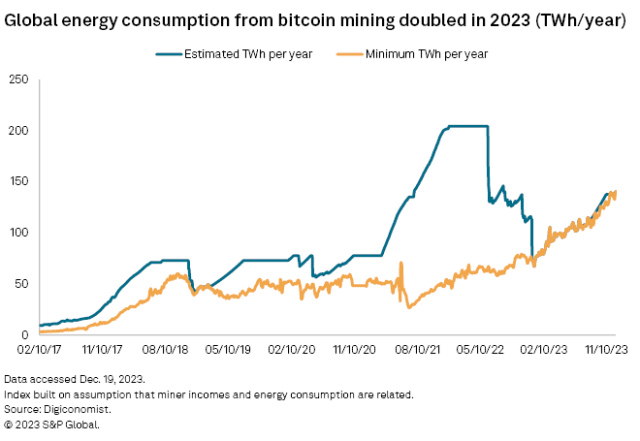
The U.S. Energy Information Administration (EIA) announced on Wednesday its intention to intensify monitoring of electricity consumption by cryptocurrency mining companies operating within the United States.
In response to growing concerns about the environmental impact of cryptocurrency mining, the EIA plans to initiate a comprehensive survey targeting select bitcoin miners.
The agency is set to launch the survey next week, requiring participating miners to provide detailed information regarding their energy usage. This initiative is part of an emergency data collection request authorized by the Office of Management and Budget on January 26.
Cryptocurrency miners have faced increased scrutiny in recent years due to the substantial energy requirements of their operations, raising concerns about their impact on power grids and carbon emissions. The EIA’s survey aims to shed light on the evolving power demand dynamics associated with cryptocurrency mining. It will also identify regions in the country where mining growth is concentrated and analyze the electricity sources powering these operations.
Global energy consumption from bitcoin mining has grown 101 percent since Jan. 1, 2023 to reach 141.2 TWh as of Dec. 20, 2023 according to data from Digiconomist.
The United States is one of the largest bitcoin miners in the world, a separate analysis by the University of Cambridge estimated.
The global crypto mining industry currently consumes as much electricity annually as Ukraine, and emits 78.7 million metric tons of CO2 per year, as much as the nation of Oman, Digiconomist estimated.
Bitcoin mining companies use powerful computers housed in sprawling datacenters to verify, process and record cryptocurrency transactions. A single bitcoin transaction using the “proof-of-work” process today requires 705 kWh of electricity, according to Digiconomist. By comparison, Ethereum uses 0.02 kWh after switching to a new approach in September 2022 known as “proof of stake,” cutting energy use 99 percent.
New York in 2022 imposed a two-year moratorium on bitcoin mining over concerns that the industry was using up too much of the state’s renewable energy resources. Members of Congress have also voiced concerns over the industry’s impact, S&P Global said in its report.
Glenn McGrath, a representative of the EIA, emphasized the significance of quantifying the energy demand from cryptocurrency mining. “We do think it is a significant source of demand which is worthy of our efforts to quantify it,” McGrath told Reuters. He added, “However, until we are able to substantiate the activity with better data, we, too, have more questions than answers.”
As an institution responsible for compiling data on various aspects of U.S. energy production and consumption, the EIA has received requests from different sectors to quantify the energy use associated with cryptocurrency mining. McGrath expressed hope that the agency would have more information to share in the coming months as they proceed with their survey.
The Rocky Mountain Institute, a Colorado-based non-profit organization focused on the transition to clean energy, estimated last year that bitcoin’s global energy consumption amounts to 127 terawatt-hours (TWh) annually.
This figure surpasses the entire yearly energy consumption of Norway, highlighting the scale of energy consumption associated with cryptocurrency mining. The EIA’s upcoming survey is expected to contribute valuable insights into this rapidly evolving and energy-intensive sector.
Baburajan Kizhakedath






